|

The
Dean River, BC
If
you dream of world-class fishing, in pristine waters surrounded
by untouched natural splendor, the Cariboo Chilcotin Coast region
(map of region) of
British Columbia is a place you will want to visit.
This
region offers several thousand lakes teaming with wild Rainbow
trout. Hundreds of miles of coastal inlets are home to Chinook,
Coho, Sockeye, Pink and Chum salmon, not to mention huge halibut,
lingcod, and rockfish. Countless miles of rivers and streams bearing
names such as The Dean, Atnarko, Bella Coola, Kwatna, Chilco,
Taseko, Chilcotin, Quesnel and Blackwater are beckoning to be
explored. It almost sounds too good to be true! The Cariboo-Chilcotin-Coast
has truly earned a reputation as one of the richest sport fishing
areas in the world.
Dreams
do come true in this part of BC and if your dream involves tying
into a chrome-bright trophy steelhead, look no further than the
legendary Dean River (map of Dean
River). The Dean River, a coastal BC wilderness river
that many anglers believe to be the finest summer run steelhead
stream in North America.
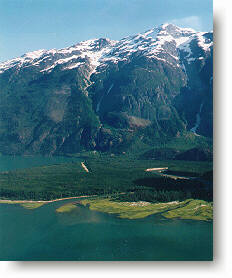 The Dean River starts its life in Nimpo
Lake flowing out as a small stream. It begins to meander slowly
to the northwest and into nearby Anahim Lake. It then continues
onward past Abuntlet and Lessard Lake towards Tweedsmuir Provincial
Park. This upper headwater section of the river to
Abuntlet Lake
is accessible by boat and is best known for its resident wild
rainbow trout. Services and facilities, which include many fine
resorts and lodges, can be found in the nearby communities of
Nimpo Lake (referred to as the float plane capital of BC) and
Anahim Lake. Once inside Tweedsmuir Park, the Dean River turns
to the west, travelling downward through the Coast mountain range
to the Dean Channel and out into the Pacific Ocean. The lower
portion of the Dean, from the mouth of the river to Crag Creek,
is the salmon and steelhead section and can only by reached by
boat via Dean Channel or by air. The Dean River starts its life in Nimpo
Lake flowing out as a small stream. It begins to meander slowly
to the northwest and into nearby Anahim Lake. It then continues
onward past Abuntlet and Lessard Lake towards Tweedsmuir Provincial
Park. This upper headwater section of the river to
Abuntlet Lake
is accessible by boat and is best known for its resident wild
rainbow trout. Services and facilities, which include many fine
resorts and lodges, can be found in the nearby communities of
Nimpo Lake (referred to as the float plane capital of BC) and
Anahim Lake. Once inside Tweedsmuir Park, the Dean River turns
to the west, travelling downward through the Coast mountain range
to the Dean Channel and out into the Pacific Ocean. The lower
portion of the Dean, from the mouth of the river to Crag Creek,
is the salmon and steelhead section and can only by reached by
boat via Dean Channel or by air.
Air
charters to the Lower Dean are based at the nearby communities
of Nimpo Lake, Anahim Lake, and Bella Coola. Flights can also
be arranged to fly directly from 100 Mile House, Williams Lake
and Quesnel. Daily scheduled flights connect Vancouver to Williams
Lake and Quesnel (with an airtime of approximately one hour).
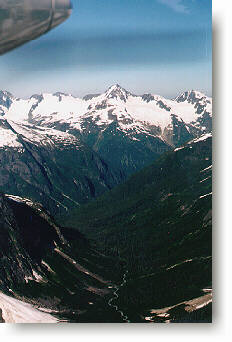 Another
interesting route to the Dean is travelling by ferry from Port
Hardy on northern Vancouver Island to Bella Coola and then chartering
a boat, plane or helicopter to the river. Another
interesting route to the Dean is travelling by ferry from Port
Hardy on northern Vancouver Island to Bella Coola and then chartering
a boat, plane or helicopter to the river.
If
you feel like seeing a lot of country and spending a couple days
doing it, travelling by land is definitely the way to go. From
Vancouver you can take a wonderful back country ramble by travelling
north on Hwy. 99 through the resort town Whistler, and then continuing
on past Duffy Lake which will lead you into Cariboo country at
Lillooet. Continue east from Lillooet on Hwy. 99 and you will
run into Hwy.97, where you will turn north and travel on to Williams Lake,
"the Hub" of the Cariboo. Approximate travel time is
7 hours.
Williams
Lake can also be reached by taking the primary route, which is
the Trans Canada Hwy. 1 from Vancouver to Cache Creek. You will
travel through the spectacular Fraser and Thompson Canyons. From
Cache Creek travel north on Hwy. 97 to Williams Lake. This route
is 540 km./335 miles in length, with an approximate travel time
of 6 hours.
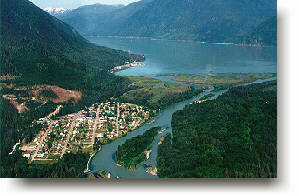 Nimpo Lake, Anahim Lake and Bella Coola can all be
reached by travelling west on Hwy. 20
from Williams Lake. Hwy. 20 will take you from the Cariboo
through the Chilcotin and down to the coast at Bella Coola. Williams
Lake to the headwaters of the Dean at Anahim Lake is approximately
317 km./196 miles with a travel time of about 4 hours. Nimpo Lake, Anahim Lake and Bella Coola can all be
reached by travelling west on Hwy. 20
from Williams Lake. Hwy. 20 will take you from the Cariboo
through the Chilcotin and down to the coast at Bella Coola. Williams
Lake to the headwaters of the Dean at Anahim Lake is approximately
317 km./196 miles with a travel time of about 4 hours.
Bella
Coola can be reached within 2 hours from Anahim Lake
by travelling west on Hwy. 20 for another 140km./86 miles. Approximately
287 km./178 miles of Hwy. 20 is paved while the remaining 176
km./109 miles consists of well maintained gravel road. One note
of caution: At Heckman Pass located just inside Tweedsmuir Provincial
Park you will be at an elevation of 1524meters/4999feet. From
this point you will begin descending into the Bella Coola Valley,which
is at almost sea level. At one point during your descent you will
encounter "The Hill", which consists of one 9km./5.6mile
section of narrow gravel switchbacks, with grades up to 18% .
Travellers should use low gear and proceed with caution. There
are pull-overs along this stretch to allow room for large transport
trucks to pass and for you to cool your brakes if needed. You
should expect excellent road conditions from May to October. From
mid October to March you can expect snow. April is spring break-up.
The trip from Vancouver to Bella Coola is an adventure and is
truly spectacular with countless Points of
Interest along the way.
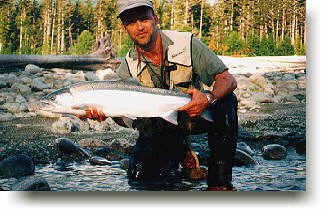 A variety of anadromous and resident sports fish are available
in the lower Dean River, including a fine Chinook salmon run
that starts in June and continues through to mid-July. But no
matter how good the salmon fishery is, the Dean River will always
and forever be best known for its fabulous summer steelhead. A variety of anadromous and resident sports fish are available
in the lower Dean River, including a fine Chinook salmon run
that starts in June and continues through to mid-July. But no
matter how good the salmon fishery is, the Dean River will always
and forever be best known for its fabulous summer steelhead.
The
Steelhead enter the river
at two different times. First is a late spring run bound for the
Takia River, a main branch of the Dean, approximately 72 km./45
miles from the ocean. The second run enters the Dean a few weeks
later and are considered the Dean River Main fish as they will
spawn in the Dean itself. Many consider these fish to be 2 distinct
races of steelhead long separated by their headwater destinations.
Certainly this could be true, however it has yet to be proven.
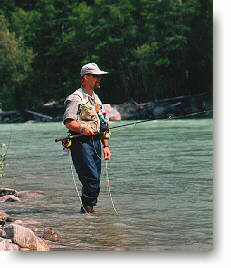 Many anglers believe the Dean River to be the strongest of all
steelhead. One explanation that could account for their strength
is the great physical effort that is required to overcome the
falls on the lower Dean. Another reason is that the majority of
the Dean River's steelhead enter freshwater approximately the
same time the steelhead enter the Skeena River bound for the Kispiox,
Sustut, Babine and Bulkley rivers. The Dean River is a July and
August fishery while the Skeena River tributaries are best known
for their fall fishing. This means two things: first, the Dean
River runs are immediately available to fishermen, sometimes only
hours from the ocean and their condition is superb. Often sea
lice are still found on these chromers when caught. The fish found
in the upstream tributaries of Skeena have been in freshwater
a long time before they become available to fishermen and are
often colored and sluggish despite their great size. Second, when
the Dean River fish enter freshwater they are fished during the
warmer water conditions of summer. Steelhead are far more active
and aggressive when the normally frigid waters are warmed in early
summer. These fish are definitely not shy! They hit the fly hard!
Kispiox, Babine, Sustut and Bulkley runs are fished in cooler
water during a cooler period of the year. This acts like a damper
on the steelhead's metabolism. The fish slow down and become more
lethargic as the water gets colder. Whatever the reason for their
great strength, the Dean River steelhead have fulfilled many a
fisherman's dream of an ocean fresh trophy fish. Many anglers believe the Dean River to be the strongest of all
steelhead. One explanation that could account for their strength
is the great physical effort that is required to overcome the
falls on the lower Dean. Another reason is that the majority of
the Dean River's steelhead enter freshwater approximately the
same time the steelhead enter the Skeena River bound for the Kispiox,
Sustut, Babine and Bulkley rivers. The Dean River is a July and
August fishery while the Skeena River tributaries are best known
for their fall fishing. This means two things: first, the Dean
River runs are immediately available to fishermen, sometimes only
hours from the ocean and their condition is superb. Often sea
lice are still found on these chromers when caught. The fish found
in the upstream tributaries of Skeena have been in freshwater
a long time before they become available to fishermen and are
often colored and sluggish despite their great size. Second, when
the Dean River fish enter freshwater they are fished during the
warmer water conditions of summer. Steelhead are far more active
and aggressive when the normally frigid waters are warmed in early
summer. These fish are definitely not shy! They hit the fly hard!
Kispiox, Babine, Sustut and Bulkley runs are fished in cooler
water during a cooler period of the year. This acts like a damper
on the steelhead's metabolism. The fish slow down and become more
lethargic as the water gets colder. Whatever the reason for their
great strength, the Dean River steelhead have fulfilled many a
fisherman's dream of an ocean fresh trophy fish.
 The best time to fish the lower section
of the Dean (from tide water to the lower canyon located about
3km./2miles upstream) is from mid July to mid September. The last
week in July to September 1 is considered the best time to fish
the upper section (from just above the lower canyon to Crag Creek).
Excellent drifts are found in the upper section from Kalone Creek
down to the lower canyon. The best time to fish the lower section
of the Dean (from tide water to the lower canyon located about
3km./2miles upstream) is from mid July to mid September. The last
week in July to September 1 is considered the best time to fish
the upper section (from just above the lower canyon to Crag Creek).
Excellent drifts are found in the upper section from Kalone Creek
down to the lower canyon.
The
first 5 miles of river can be accessed via gravel road. There
is no road access from that point on, however jet boat transport
can be arranged to carry you and your supplies to the upper drifts
of the river. Guiding services are available and can be arranged
before reaching the Dean. Camping is allowed along the river banks,
however there are some resorts located in the lower portion of
the Dean.
The
Dean River is a treasure and is considered one of the best managed
rivers in the world. Special regulations are in place, including
fly fishing only sections. Before heading to the Dean, anglers
should consult the current BC Freshwater Fishing Regulations Synopsis
or contact the Cariboo Ministry of the Environment Office located
at Suite 400, 640 Borland Street, Williams Lake, B.C. V2G 4T1,
phone (250) 398-4530.
|




 The Dean River starts its life in Nimpo
Lake flowing out as a small stream. It begins to meander slowly
to the northwest and into nearby Anahim Lake. It then continues
onward past Abuntlet and Lessard Lake towards
The Dean River starts its life in Nimpo
Lake flowing out as a small stream. It begins to meander slowly
to the northwest and into nearby Anahim Lake. It then continues
onward past Abuntlet and Lessard Lake towards  Another
interesting route to the Dean is travelling by ferry from Port
Hardy on northern Vancouver Island to Bella Coola and then chartering
a boat, plane or helicopter to the river.
Another
interesting route to the Dean is travelling by ferry from Port
Hardy on northern Vancouver Island to Bella Coola and then chartering
a boat, plane or helicopter to the river.  Nimpo Lake, Anahim Lake and Bella Coola can all be
reached by travelling west on
Nimpo Lake, Anahim Lake and Bella Coola can all be
reached by travelling west on  A variety of anadromous and resident sports fish are available
in the lower Dean River, including a fine
A variety of anadromous and resident sports fish are available
in the lower Dean River, including a fine  Many anglers believe the Dean River to be the strongest of all
steelhead. One explanation that could account for their strength
is the great physical effort that is required to overcome the
falls on the lower Dean. Another reason is that the majority of
the Dean River's steelhead enter freshwater approximately the
same time the steelhead enter the Skeena River bound for the Kispiox,
Sustut, Babine and Bulkley rivers. The Dean River is a July and
August fishery while the Skeena River tributaries are best known
for their fall fishing. This means two things: first, the Dean
River runs are immediately available to fishermen, sometimes only
hours from the ocean and their condition is superb. Often sea
lice are still found on these chromers when caught. The fish found
in the upstream tributaries of Skeena have been in freshwater
a long time before they become available to fishermen and are
often colored and sluggish despite their great size. Second, when
the Dean River fish enter freshwater they are fished during the
warmer water conditions of summer. Steelhead are far more active
and aggressive when the normally frigid waters are warmed in early
summer. These fish are definitely not shy! They hit the fly hard!
Kispiox, Babine, Sustut and Bulkley runs are fished in cooler
water during a cooler period of the year. This acts like a damper
on the steelhead's metabolism. The fish slow down and become more
lethargic as the water gets colder. Whatever the reason for their
great strength, the Dean River steelhead have fulfilled many a
fisherman's dream of an ocean fresh trophy fish.
Many anglers believe the Dean River to be the strongest of all
steelhead. One explanation that could account for their strength
is the great physical effort that is required to overcome the
falls on the lower Dean. Another reason is that the majority of
the Dean River's steelhead enter freshwater approximately the
same time the steelhead enter the Skeena River bound for the Kispiox,
Sustut, Babine and Bulkley rivers. The Dean River is a July and
August fishery while the Skeena River tributaries are best known
for their fall fishing. This means two things: first, the Dean
River runs are immediately available to fishermen, sometimes only
hours from the ocean and their condition is superb. Often sea
lice are still found on these chromers when caught. The fish found
in the upstream tributaries of Skeena have been in freshwater
a long time before they become available to fishermen and are
often colored and sluggish despite their great size. Second, when
the Dean River fish enter freshwater they are fished during the
warmer water conditions of summer. Steelhead are far more active
and aggressive when the normally frigid waters are warmed in early
summer. These fish are definitely not shy! They hit the fly hard!
Kispiox, Babine, Sustut and Bulkley runs are fished in cooler
water during a cooler period of the year. This acts like a damper
on the steelhead's metabolism. The fish slow down and become more
lethargic as the water gets colder. Whatever the reason for their
great strength, the Dean River steelhead have fulfilled many a
fisherman's dream of an ocean fresh trophy fish. The best time to fish the lower section
of the Dean (from tide water to the lower canyon located about
3km./2miles upstream) is from mid July to mid September. The last
week in July to September 1 is considered the best time to fish
the upper section (from just above the lower canyon to Crag Creek).
Excellent drifts are found in the upper section from Kalone Creek
down to the lower canyon.
The best time to fish the lower section
of the Dean (from tide water to the lower canyon located about
3km./2miles upstream) is from mid July to mid September. The last
week in July to September 1 is considered the best time to fish
the upper section (from just above the lower canyon to Crag Creek).
Excellent drifts are found in the upper section from Kalone Creek
down to the lower canyon.